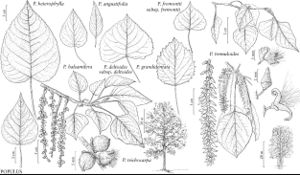Populus tremuloides
Fl. Bor. Amer. 2: 243. 1803.
Plants to 35 m, 10 dm diam.; moderately heterophyllous. Bark dark gray, shallowly furrowed only basally on large trees, (greenish or yellowish white to gray and smooth otherwise). Branchlets reddish-brown, becoming grayish yellow by third year, round, 1.2–3.5 (–5) mm diam., coarse or not, glabrous. Winter buds reddish-brown, glabrous, (shiny), slightly resinous; terminal buds (2.5–) 4–6 (–9) mm, (glabrous); flowering buds separated on branchlets or clustered distally, (4.5–) 6–10 (–11) mm. Leaves: petiole distally flattened at right angle to plane of blade, (0.7–) 1–6 cm, about equaling blade length; blade somewhat circular to ovate, (1–) 3–7 (–12) × (0.5–) 3–7 (–10.5) cm, w/l = ca. 1, base shallowly cuneate to subcordate, shouldered, basilaminar glands (0 or) 1 or 2, round, margins not translucent, not ciliate, apex acuminate to acute, abaxial surface whitish green, resin stains not obvious, (slightly glaucous), glabrous, adaxial dark green, glabrous; preformed blade margins subentire to finely crenate-serrate throughout, teeth (12–) 18–30 (–42) on each side, sinuses 0.1–1 mm deep, (surfaces glabrous or sparsely sericeous); neoformed blade margins finely crenate-serrate throughout, teeth (20–) 25–40 (–50) on each side, sinuses 0.1–1.3 mm deep. Catkins densely (20–) 50–65 (–130) -flowered, (1.7–) 4–7 (–12.5 in fruit) cm; floral bract apex deeply cut, ciliate. Pedicels 0.5–1.5 (–2 in fruit) mm. Flowers: discs narrowly cupshaped, obviously oblique, entire, 1.3–1.8 (–3 in fruit) mm diam.; stamens 6–12; anthers truncate; ovary 2-carpelled; stigmas 2, filiform, basal lobes expanded, erect. Capsules narrowly ovoid, (2–) 2.5–4.5 (–7) mm, glabrous, 2-valved. Seeds (3–) 5–7 (–9) per placenta. 2n = 38, 57, 76.
Phenology: Flowering Mar–Jun; fruiting May–Jul.
Habitat: Dry to wet, open to closed woodlands and forests, edges of meadows and prairies, talus-slopes and canyon-heads, sites of human disturbance, timber cuts, mine tailings, gravel pits, quarries, roadsides
Elevation: 0-3000(-4000) m
Distribution

St. Pierre and Miquelon, Alta., B.C., Man., N.B., Nfld. and Labr. (Nfld.), N.W.T., N.S., Ont., P.E.I., Que., Sask., Yukon, Alaska, Ariz., Calif., Colo., Conn., Del., Idaho, Ill., Ind., Iowa, Maine, Md., Mass., Mich., Minn., Mo., Mont., Nebr., Nev., N.H., N.J., N.Mex., N.Y., N.C., N.Dak., Ohio, Oreg., Pa., R.I., S.Dak., Tex., Utah, Vt., Va., Wash., W.Va., Wis., Wyo., Mexico (Baja California), Mexico (Chihuahua), Mexico (Coahuila), Mexico (Nuevo León), Mexico (Tamaulipas), Mexico (south to Hidalgo and the state of Mexico)
Discussion
Clonal aspen groves develop rapidly following fires and other disturbances and may quickly decay in their absence as infections are transmitted through the connecting root system. Populus tremuloides is the most widely distributed tree in North America, found throughout cold and cool-temperate regions from coast to coast and from within the Arctic Circle to the north rim of the Valley of Mexico. It ranges from sea level in the north and east to the north slopes of high mountains in the southernmost part of its range. The southerly locations, like that on Mt. Livermore in the Davis Mountains, Texas, the most southerly stand in the flora area, may be Pleistocene relicts. Groves are often occupied by single clones and show no sexual reproduction but persist and spread by root suckers. Clone formation commonly results also in striking differences in appearance and phenology of adjacent groves or blocks of trees (B. V. Barnes 1969). Some individuals display a particularly rich, yellow autumn coloration that makes them a standout among North American trees, particularly in the West, where this richness was the basis for segregation of P. tremuloides var. aurea. There do not appear to be consistent regional differences within the species that would justify recognition of subspecies or varieties (Barnes 1975). Instead, there is as much variation from clone to clone within a region as there is among regions.
Populus tremuloides hybridizes with both the native P. grandidentata (P. ×smithii B. Boivin) and the Eurasian P. alba (P. ×heimburgeri B. Boivin) in southeastern Canada and the northeastern United States (B. V. Barnes 1961; T. A. Spies and Barnes 1982). Populus ×smithii occurs as far west as the Niobrara River valley, Nebraska, ca. 350 km west of the nearest present populations of P. grandidentata. Preformed leaves are more ovate than those of P. tremuloides and have larger teeth. Populus ×heimburgeri has transiently tomentose twigs, buds, and abaxial leaf surfaces. Contrary to some published reports (E. Lepage 1961; T. C. Brayshaw 1965b; B. Boivin 1966b; F. G. Bernard 1968), P. tremuloides does not hybridize naturally with P. angustifolia, P. balsamifera, or P. deltoides. The correct identification of such specimens is discussed under each of the purported parents.
The closely related Eurasian aspen, Populus tremula Linnaeus, is sometimes cultivated in North America, particularly as a columnar staminate clone (‘Erecta’). Its leaves are very similar in shape to those of P. tremuloides and usually have slightly larger teeth. Buds are often minutely hairy. Artificial hybrids between P. tremula and P. tremuloides, P. ×wettsteinii Hämet-Ahti, are sometimes grown for plantation forestry, particularly in the Great Lakes region.
Selected References
None.
